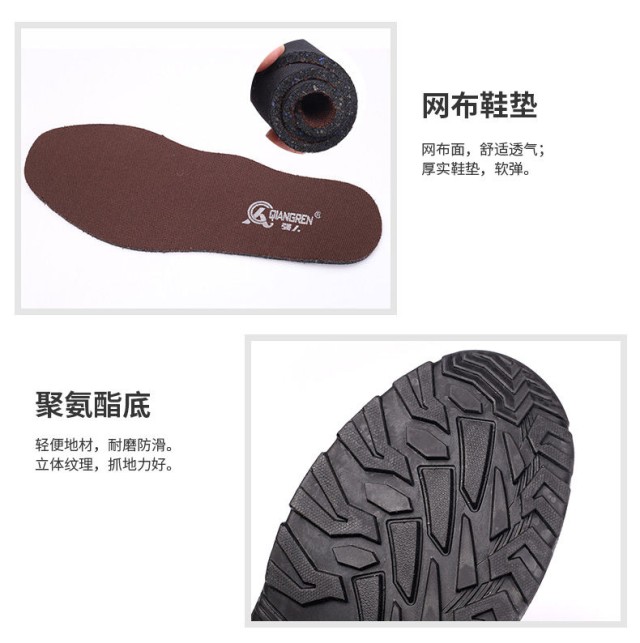The right work boot sole can mean the difference between a productive shift and preventable injuries. Modern engineering now delivers puncture-resistant protection, all-day comfort, and hazard-specific traction in designs that weigh significantly less than traditional options. Here's what professionals need to know about these advancements.
Work Boot Sole Engineering Demystified
Material Science Behind Puncture Resistance
Puncture-resistant soles aren’t just thick—they’re intelligently layered. Most combine:
- Steel or composite plates embedded in the midsole to block sharp objects
- TPU (thermo-polyurethane) or proprietary polyurethane overlays for oil/abrasion resistance
- Shock-absorbing EVA foam underfoot to reduce fatigue
ASTM F2412-18a testing proves effectiveness by simulating real-world hazards:
- Nails or screws driven at speeds mimicking a worker stepping down forcefully
- Composite plates stopping penetration while remaining 30–40% lighter than full steel equivalents
Key Insight: TPU’s split resistance makes it ideal for demolition sites, while EVA’s cushioning benefits healthcare workers standing for 10+ hours.
Traction Patterns for Hazard-Specific Environments
Tread design varies more than most realize:
| Hazard Type | Sole Pattern Feature | Industry Use Case |
|---|---|---|
| Wet/oily surfaces | Deep multidirectional lugs | Oil rigs, commercial kitchens |
| Uneven terrain | Aggressive zigzag cleats | Construction, forestry |
| Ice/snow | Micro-textured rubber + studs | Utility work in winter |
Proprietary rubber compounds (e.g., oil-resistant nitrile) further enhance grip by remaining flexible in sub-zero temperatures.
Lightweight Innovations in Industrial Footwear
The shift from all-rubber soles to hybrid designs cuts weight by ~25% without sacrificing durability:
- TPU/EVA combos – TPU wraps the perimeter for abrasion resistance while EVA cushions the footbed
- Dual-density PU – Firmer forefoot zones for stability, softer heels for impact absorption
- 3D-printed midsoles – Customized arch support that reduces knee/hip strain over time
Field Data: Warehouse workers report 18–22% less fatigue when switching to boots under 2.5 lbs (1.1 kg) per pair.
Industry Applications and User Scenarios
Construction Sites vs. Oil Rig Demands
High-rise construction crews prioritize:
- Electrical hazard (EH) protection from conductive materials
- Wide toe boxes for stability on rebar grids
- Shock diffusion from repeated ladder climbs
Offshore oil workers need:
- Acid-resistant outsoles for chemical exposure
- Quick-drain channels in flooded walkways
- Insulation against metal decking in winter
Pro Tip: Look for ASTM F2413-18 certification if metatarsal guards or static dissipation are required.
Longevity Testing and Wear Patterns
Stress tests reveal how soles degrade:
- Flex fatigue – After ~1,200 bends (simulating 6 months of use), EVA foams compress 15–20%
- Abrasion cycles – Quality TPU lasts 2–3× longer than standard rubber in gravel environments
- Chemical exposure – Nitrile outsoles withstand fuel spills 50% longer than natural rubber
Rotate two pairs to extend lifespan—drying time between wears prevents midsole breakdown.
Upgrade Your Safety Footwear Inventory
3515’s engineered soles meet ASTM/ISO standards while addressing real-world comfort gaps. Distributors and bulk buyers can request material samples to verify puncture resistance, flexibility, and weight—critical factors for end users in heavy industry.
Ready to stock boots that workers actually want to wear? Contact our industrial footwear team for volume pricing on OSHA-compliant designs.
Related Products
- Wholesale Customizable Suede Safety Boots - Puncture-Proof with Velcro Closure
- Safety Footwear Wholesale Manufacturer for Custom OEM/ODM Production
- Wholesale Anti-Smash & Puncture-Proof Safety Shoes Custom Manufacturing for Brands
- Wholesale Safety Footwear Manufacturer for Bulk & Custom OEM Orders
- Customizable Anti-Smash Safety Boots for Wholesale & Private Label Manufacturing
Related Articles
- How to Choose Work Boots That Match Your Job's Safety Demands
- Matching Men’s Work Shoe Safety Technologies to Workplace Hazards
- How to Choose Work Boots That Match Your Job Demands and Safety Needs
- How to Choose Work Boots That Match Your Industry's Safety Needs
- How to Choose Work Boot Materials for Maximum Safety and Durability



















